→ Pay attention
→ Top rated
| # | User | Rating |
|---|---|---|
| 1 | tourist | 3856 |
| 2 | jiangly | 3747 |
| 3 | orzdevinwang | 3706 |
| 4 | jqdai0815 | 3682 |
| 5 | ksun48 | 3591 |
| 6 | gamegame | 3477 |
| 7 | Benq | 3468 |
| 8 | Radewoosh | 3462 |
| 9 | ecnerwala | 3451 |
| 10 | heuristica | 3431 |
→ Top contributors
| # | User | Contrib. |
|---|---|---|
| 1 | cry | 168 |
| 2 | -is-this-fft- | 162 |
| 3 | Dominater069 | 160 |
| 4 | Um_nik | 159 |
| 5 | atcoder_official | 156 |
| 6 | djm03178 | 153 |
| 6 | adamant | 153 |
| 8 | luogu_official | 149 |
| 9 | awoo | 148 |
| 10 | TheScrasse | 146 |
→ Find user
→ Recent actions
↑
↓
Codeforces (c) Copyright 2010-2025 Mike Mirzayanov
The only programming contests Web 2.0 platform
Server time: Feb/17/2025 04:23:45 (l1).
Desktop version, switch to mobile version.
Supported by
User lists


| Name |
|---|












Auto comment: topic has been updated by Parvej (previous revision, new revision, compare).
Just try to backtracking/bruteforces. Each vertices during the visit will be marked (not go to that vertice again), else unmark it. The complexity will be $$$O(n!)$$$ time
SPyofgame I think time complexity will be O ((N^2) * (N!)) as for each path there will be N^2 computation right? Correct me if I am wrong. Thanks in advance.
I dont think we need $$$O(n^2)$$$ for each $$$O(n!)$$$ path since you can try to implement directly or something similar.
By the way, $$$O(n^2)$$$ is also considerably small compared to $$$O(n!)$$$. So unless the time limit is small, you can try to improve the complexity by changing implementation or even a bit of heuristic — which can provide better complexity and constant.